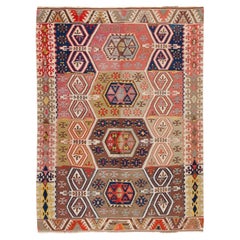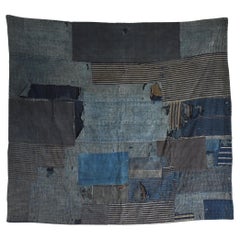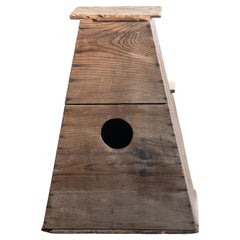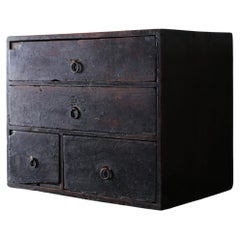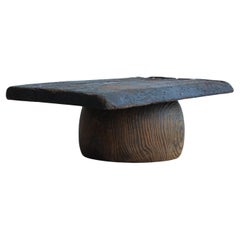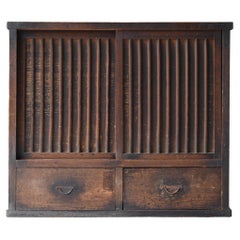Japan
to
60
74,707
59,307
2,292
1,372
934
434
411
357
303
164
136
110
101
90
84
73
56
52
48
47
41
40
26
23
15
12
9
7
7
6
6
6
5
5
4
4
4
3
3
2
2
2
1
1
1
1
1
1
1
9
1
1
1
1
Period: Early 20th Century
Period: Mid-19th Century
Antique Konya Kilim Rug Wool Old Central Anatolian Turkish Carpet
Located in Tokyo, JP
This is Central Anatolian Antique Kilim from the Konya region with a rare and beautiful color composition.
This highly collectible antique kilim has wonderful special colors and tex...
Category
Early 20th Century Turkish Kilim Japan
Materials
Wool, Natural Fiber
Japanese "BORO" 1800s-1860s / Tapestry Rug Wabi Sabi
Located in Chōsei District Nagara, JP
This BORO is an extremely valuable old cloth made in Japan during the Edo period (1800s-1860s).
It is filled with the wisdom and history of people's lives who, in order to survive th...
Category
Mid-19th Century Japanese Edo Antique Japan
Materials
Fabric
Antique Japanese large 2-step wood step stool, Fumidai wabi sabi organic mingei
Located in 常陸大宮市, JP
Antique Wooden step stool, "Fumidai", made of Sugi Cedar - New finds from a Kominka (old traditional style house) in Ibaraki pref., Japan.
Manufactured in Circa 1900s - 1930s (Taisho...
Category
Early 20th Century Japanese Folk Art Japan
Materials
Wood, Cedar
Japanese Antique Wabi Sabi Small Drawer 1860s-1900s
Located in Sammu-shi, Chiba
Very old Japanese small drawer.
This furniture is from the Meiji period (1860s-1900s).
It is made of cedar wood.
The round handles are made of iron.
These drawers are tasteful, rust...
Category
Early 20th Century Japanese Meiji Japan
Materials
Cedar
Japanese Antique Table, Table Wabi Sabi Mingei
Located in Katori-Shi, 12
This low table is a harmonious combination of a single piece of wood from the Meiji to Taisho eras (1986-1926) and a traditional brazier.
The table top is made of chestnut wood and ...
Category
Early 20th Century Japanese Taisho Japan
Materials
Wood
Japanese Tansu 1860s-1900s / Cabinet Sideboard Wabi Sabi
Located in Chōsei District Nagara, JP
This is a medium sized Tansu made in Japan.
Made in the Meiji period (1860s-1900s), it is a gem of history and aesthetics.
The material used is cedar wood. The drawer handles are ma...
Category
Early 20th Century Japanese Meiji Japan
Materials
Iron
Japanese Silver Screen Pair, Meiji Period, Herons & Plovers, Shijo School
Located in Kyoto, JP
Heron & Plovers
Ink and silver leaf on paper
Maekawa Bunrei (1837-1917)
A pair of low six-panel Japanese screens by Maekawa Bunrei, a later master of the Kyoto based Shijo school of painting. On the right screen a solitary white heron stands motionless in a stream. On the left screen plovers play along a shoreline. The elegant forms are executed employing fluid, minimalistic ink brushstrokes. The soft brushstrokes and the sharp light of the silver leaf lend the scenes a sense of translucence. The sophisticated composition superbly exploits the long, horizontal pictorial surface of the pair of folding screens...
Category
Early 1900s Japanese Meiji Antique Japan
Materials
Silver Leaf
Japanese Primitive Large Coffee Table 1860s-1900s / Side Table Wabi Sabi
Located in Chōsei District Nagara, JP
This is a large primitive-style coffee table made in Japan. It was made during the Meiji period (1860s-1900s) and has a massive presence that has transcended time to the present.
The...
Category
Early 20th Century Japanese Primitive Japan
Materials
Wood
Old Japanese Scholar's Stone / Beautiful Appreciation Stone/Natural Stone
Located in Sammu-shi, Chiba
This is a stone mined in Japan. Measure: w 22cm.
Not only in China but also in Japan from ancient times, rocks in the mountains have been shaved and stones for viewing have been qua...
Category
Early 20th Century Japanese Showa Japan
Materials
Stone
19th Century Japanese Silk Painting by Kano Chikanobu, Phoenix & Paulownia
Located in Kyoto, JP
Birds & Flowers of the seasons
Pheasants & Plum in Snow
Unframed painting. Ink, pigment and gofun on silk
Kano Chikanobu 1819-1888
Signature...
Category
Mid-19th Century Asian Edo Antique Japan
Materials
Silk
Japanese Antique Drawer 1920s-1940s / Paulownia chest of drawer
Located in Sammu-shi, Chiba
This is a very old Japanese drawer storage.
This is from the Early Showa period (1920s-1940s).
The material is Paulownia.
Paulownia wood is the least prone to warping and deformatio...
Category
Early 20th Century Japanese Showa Japan
Materials
Cedar
Japanese Antique Drawer storage shelf chest Japandi
Located in Chiba, Chiba
This is an old Japanese drawer storage shelf.
It was made in the early Showa period.
It is made from Sen wood.
The light wood color matches the brass handle.
All drawers move smooth...
Category
Early 20th Century Japanese Japan
Materials
Wood
Japanese Antique Small Drawer 1860s-1900s / Tansu Wabi Sabi
Located in Chōsei District Nagara, JP
This is an old small drawer storage made in Japan.
The furniture was made in the Meiji period (1860s-1900s). The material is cedar wood and the handles are made of iron.
The design i...
Category
Early 20th Century Japanese Meiji Japan
Materials
Iron
Japanese Antique Large Paper Mat "Abstract art" 1860s-1920s / Wabi Sabi
Located in Chōsei District Nagara, JP
This is a very old Japanese matte paper.
It was made during the Meiji period (1860s-1920s) and is very large, measuring approximately 1900 mm x 1420 mm.
The Japanese paper is carefu...
Category
Early 20th Century Japanese Meiji Japan
Materials
Paper
Japanese Painting, Framed Panel, Willow and Sparrows, circa 1920 Taisho era
Located in Kyoto, JP
Anonymous
Summer willow and sparrows
Taisho period, circa 1920
Framed painting. Mineral pigments, mica, gold, ink and gofun on silk
Dimensions (framed):
H. 98 cm x W. 135 cm x D...
Category
1920s Japanese Taisho Vintage Japan
Materials
Wood, Silk
Japanese Framed Silk Painting, Turtledoves and Peaches, Taisho Era, circa 1920
Located in Kyoto, JP
Nakamura Daizaburo
Turtledoves in a Peach Tree
Taisho period, circa 1920
Framed painting. Mineral pigments, ink and gofun on silk
Signed: Daizaburo
Dimensions (framed)...
Category
1910s Japanese Taisho Vintage Japan
Materials
Wood, Silk
Japanese Primitive Armchair 1860s-1920s / Side Chair Wabi Sabi
Located in Chōsei District Nagara, JP
This primitive-style armchair is steeped in Japanese tradition and aesthetics.
It was created in the Meiji and Taisho periods (1860s-1920s) for its powerful yet delicate beauty.
Bold...
Category
Early 20th Century Japanese Primitive Japan
Materials
Wood
Japanese Antiques 6panels, Gold back, crane and pine, Araki Jippo folding screen
Located in Niiza, JP
Material: gold background paper, wooden frame
One piece: W730 x H1760 mm, unfolded size: W4420 mm, 13 kg
Folded size: W750 x H1760 x D100 mm
Estimated packaging (sandwiched with 5 mm...
Category
Early 20th Century Japanese Japan
Materials
Paper
Japanese Painting, Hanging Scroll, Mid 19th Century, Koi and Water Plants
By Iwase Hirotaka
Located in Kyoto, JP
Iwase Hirotaka (1808-1877)
Koi and Water Plants
Hanging scroll, ink, color, gold wash and gold flecks on silk
Inscription: Hirotaka
Seal: Ille...
Category
1860s Japanese Edo Antique Japan
Materials
Silk
Japanese Antique Chests of Drawers 1860s-1900s /Tansu, Wabi-Sabi
Located in Katori-Shi, 12
This small drawer was produced in the Taisho period.
This chest is made of sturdy cedar with a lacquer finish, with a base panel made of lightweight paulownia wood and an iron handl...
Category
Early 20th Century Japanese Taisho Japan
Materials
Wood
Primitive Wood Chair with old leather from Philippines / Wabi Sabi Mingei
Located in Sammu-shi, Chiba
This is an antique chair from the Philippines.
The design is made of leather held together with wood parts. This is a primitive piece with a distinctive curved leg design and old lea...
Category
Early 20th Century Philippine Meiji Japan
Materials
Wood
Antique Japanese leather chair, Primitive Chair, Wabi-Sabi
Located in Katori-Shi, 12
This is an antique chair from the Showa era.
The deep-colored genuine leather has a unique texture and soft feel that comes from years of use. You can enjoy the changes in the leath...
Category
Early 20th Century Japanese Showa Japan
Materials
Leather
Japanese Large Stacking Tansu 1860s-1920s / Cabinet Wabisabi
Located in Chōsei District Nagara, JP
This is a Stacking Tansu made in Japan.
It was made between the Meiji and Taisho periods (1860s-1920s), and is a traditional storage furniture with Japanese craftsmanship.
The materi...
Category
Early 20th Century Japanese Meiji Japan
Materials
Iron
Japanese Antique Cabinets, Wabi Sabi, Japandi
Located in Katori-Shi, 12
This is an antique Japanese-style cabinet made in the Meiji period.
The texture of the black lacquer, smoked with soot from the hearth, has a unique depth and charm that is unlike a...
Category
Early 20th Century Japanese Meiji Japan
Materials
Wood
Japanese vtg low table. solid hardwood tabletop & antique leg frame. wabi sabi
Located in 常陸大宮市, JP
Japanese antique low dining table / Kotatsu (heated table) for 4 people.
Tabletop material is made of single solid hardwood, original paint remains on the backside, which gives anoth...
Category
Early 20th Century Japanese Showa Japan
Materials
Hardwood, Cedar
Japanese Antique Low Table, Wabi Sabi
Located in Katori-Shi, 12
This is an antique wooden low table from the Meiji period (1986-1912).
The curved legs are beautiful.
It was used as a workbench by craftsmen at the time.
The material is high-qual...
Category
Early 20th Century Japanese Meiji Japan
Materials
Wood
Japanese antique tree stump low table/coffee table/stool
Located in Sammu-shi, Chiba
This is an item cut from an old Japanese tree with a knot.
It was originally used as a brazier, but the bottom is beautiful and can be used as a table.
When viewed from the front, it...
Category
Early 20th Century Japanese Taisho Japan
Materials
Wood
Japanese Vintage Cabinet with Glass Swing Doors, Early Showa Period '1926-'
Located in Hitachiomiya-shi, 08
This vintage cabinet was crafted in the Early Showa Period '1926-'.
It features hinged glass doors with a beautiful frame made of chestnut wood. The frame has developed a lovely, w...
Category
1920s Japanese Taisho Vintage Japan
Materials
Wood
Wooden Low Table, Japanese Antique, Wabi-Sabi, Mingei
Located in Katori-Shi, 12
We will introduce a low table that exudes the charm of the Meiji era.
The low table was loved by craftsmen as a "cutting stand" during the Meiji era.
Cherry wood with a rich textur...
Category
Early 20th Century Meiji Japan
Materials
Wood
Japanese Antique Bamboo Sliding Door, Object Mingei Art Panel, Wabisabi Door(2)
Located in Katori-Shi, 12
This is an antique Japanese bamboo door.
It is from the Meiji period (1860s-1900s).
It is made mainly of cedar and bamboo.
It has a simple design that conveys the charm of the mater...
Category
Early 20th Century Japanese Meiji Japan
Materials
Bamboo, Wood
Japanese Antique Cabinets, Wabi Sabi, Japandi
Located in Katori-Shi, 12
This is a beautiful cabinet that evokes the atmosphere of the Taisho period.
It is made of lauan and cedar.
It is finished with persimmon tannins and soot, which bring out the text...
Category
Early 20th Century Japanese Taisho Japan
Materials
Wood
Kitchen Black Cabinets, Japanese Antiques, Tansu Storage, Wabi Sabi, Japandi
Located in Katori-Shi, 12
A tranquil presence in a soft black.
A simple yet distinctive display shelf.
The design has a Japanese aesthetic sense without being overly decorative.
This actually seems to bring...
Category
Early 20th Century Japanese Taisho Japan
Materials
Wood
Japanese Antique Stone Display Stand / Objet / Before 1868s / Wabi-Sabi Mingei
Located in Iwate-gun Shizukuishi-cho, Iwate Prefecture
This is an old stone stand in Japan.
I don't know the details if it was used as a stand for beating straw, but it seems to be before the end of the Edo period.
The round silhouette...
Category
Mid-19th Century Japanese Rustic Antique Japan
Materials
Stone
Primitive Japanese Flower Stand, Wooden Stools, Wabi-Sabi
Located in Katori-Shi, 12
This is an old Japanese stool made in the Taisho period (1913-1930s).
It was made by reusing the iron frame of a bicycle at a time when supplies were scarce. The wooden part is made...
Category
Early 20th Century Taisho Japan
Materials
Wood
Mid 19th Century Framed Japanese Painting. Snail, Wasp & Hollyhock.
Located in Kyoto, JP
Obata Tosho (1812-1886)
Snail, Wasp & Hollyhock
Late Edo period, mid 19th Century
Framed Japanese Painting. Ink and color on paper.
Individually framed 19th century bird and flow...
Category
Mid-19th Century Japanese Edo Antique Japan
Materials
Paper
Japanese Small Drawer 1860s-1920s / Tansu Nightstand Wabisabi
Located in Chōsei District Nagara, JP
This is a small drawer storage made in Japan.
It was made between the Meiji and Taisho periods (1860s-1920s) and is made of cedar wood. The handles are made of iron.
The lean, linea...
Category
Early 20th Century Japanese Meiji Japan
Materials
Iron
Early 20th Century Japanese Screen Pair - Ink Pine Trees on Gold
Located in Kyoto, JP
Imao Keisho (1902-1993)
Pine Trees
Early 20th Century, Circa 1930
Pair of six-panel Japanese screens. Ink on silk and gold leaf.
Dimensions: Each screen H. 67.5” x 148” (172 cm x 376 cm)
A pair of monumental six-panel Japanese pine screens by the renowned Nihonga artist Imao Keisho. Here Keisho entirely removed the background and brought the pine trees to the surface of the painting. This simplification of the elements makes the scene exceptionally direct and compelling and injects a very modern...
Category
Early 20th Century Japanese Showa Japan
Materials
Gold Leaf
Japanese Large Plastered Pottery Vase 1800s-1860s / Wabi Sabi
By Axel Vervoordt
Located in Chōsei District Nagara, JP
This is a very rare large ceramic vase made in Japan, Edo period (1800s-1860s).
I have been buying old tools and antiques in Japan for over 20 years, and this is the first time I hav...
Category
Mid-19th Century Japanese Edo Antique Japan
Materials
Pottery, Straw, Plaster
Japanese Antique Cabinets , Low board Storage , Wabi Sabi, Japandi
Located in Katori-Shi, 12
This is an antique lowboard made in Japan. In Japan, it was used as a flooring.
A flooring is a platform that can be moved, like the floorboards of a tokonoma, which is indispensabl...
Category
Early 20th Century Japanese Taisho Japan
Materials
Wood
Japanese Antique Mirror, Antique Wall Mirror(2)
Located in Katori-Shi, 12
A large mirror with curved, chamfered edges resembling kamaboko.
This is a beautiful single piece of wood mirror that has aged to develop a rich expression and a modern feel.
The mi...
Category
Early 20th Century Japanese Taisho Japan
Materials
Wood
Primitive Japanese Wooden Stools, Wabi-Sabi Stool
Located in Katori-Shi, 12
This is an old Japanese stool.
It dates from the Taisho period (1913-1930s).
It is made from Beech wood.
It is simple and tasteful, exuding a world of wabi-sabi.
It has been repair...
Category
Early 20th Century Taisho Japan
Materials
Wood
Antique Caucasus Soumak Kilim Sumac Rug, Caucasian Natural Carpet
Located in Tokyo, JP
This is a large Antique Soumak ( Sumak, Sumac ) Kilim from the Caucasus region with a rare and beautiful color composition.
Of the four countries that make up the Caucasus, Azerbaijan produces the most kilims, and the land has a long history of weaving. The nomadic tribes wove kilims and carpets as well as a wide range of storage bags and sacks, such as saffrash, khurgin and chula, and donkey and horse trappings. Smaller bags for salt, utensils, and other items are also common. Not only are the Azerbaijani weavers prolific, but they also employ many techniques at the loom. These include slitweave- known locally by the word kilim, warp-faced patterning (jajim), supplementary weft (zili), weft wrapping (popularly known as soumak), and extra weft wrapping (verneh). Furthermore, flatweaves are defined by regional names such as palas and shadda, so it is possible to ascribe a variety of weaving names to particular provenances as follows: soumaks are made in Kuba, palas, and kilims in Hajikabul, zili in Khizy, verneh and zili in Kazakh, shadda, verneh and zili in Barda, jajim in Agjabedi, and palas and kilims in Jabrail.
Soumak weave is a technique in which new weft threads are added to a plain weave fabric, and one or two warp threads are wound from the front to the back. The resulting kilim is denser and firmer, giving it a unique feel and look. This technique is commonly used in the Caucasus region.
Soumak Kilims have a very beautiful contrast between orange that shines like the sun, deep purple-tinged indigo, and astringent dark red. You can also see the unevenly dyed abrage in this sumac, which is like a magic carpet with an oriental atmosphere.
Features of the Caucasian kilim, such as the unique cosmic geometric floral pattern, are also found in this Soumak. It has a bright look, but it also has a faded and textured feel, so it can be used in a good old atmosphere. The woven fabric is particularly solid, so it is recommended for use in a solid living room or under a dining table without moving or twisting. A nice kilim under a long wooden dining table.
Category
Early 20th Century Caucasian Kilim Japan
Materials
Wool, Natural Fiber
Wooden Low Table, Japanese Antique, Wabi-Sabi, Mingei
Located in Katori-Shi, 12
Introducing our exquisite low table, a stunning example of the beauty found in wabi-sabi and traditional craftsmanship. Originally used as a sewing workbench, this piece carries a ri...
Category
Early 20th Century Meiji Japan
Materials
Wood
Japanese antique large bamboo double layered basket - wabi sabi primitive decor
Located in 常陸大宮市, JP
New finds from the farmer's barn. Japanese antique hand woven bamboo basket - can store the heavier object because of the double layered structure of thin bamboo & thick bamboo laye...
Category
Early 20th Century Japanese Showa Japan
Materials
Bamboo
Japanese Antique Table, Table Rustic Wabi Sabi Mingei
Located in Katori-Shi, 12
Introducing our unique low table, a harmonious blend of a single slab and a traditional mortar. The tabletop is crafted from a single slab of cherry wood, while the mortar base is ma...
Category
Early 20th Century Taisho Japan
Materials
Wood
Wooden Low Table, Japanese Antique, Exhibition Stand, Wabi-Sabi, Mingei
Located in Katori-Shi, 12
Introducing our exquisite low table, a masterpiece crafted from the finest materials. The tabletop is a single slab of cherry wood, while the legs are made from high-quality oak, bot...
Category
Early 20th Century Meiji Japan
Materials
Wood
Japanese Antique Exhibition Stand / Sword Case / 1800-1868s / Wabi-sabi
Located in Iwate-gun Shizukuishi-cho, Iwate Prefecture
This is an old drawer for storing Japanese swords originally called "Katanatansu".
It is thought to be from around the Edo period.
Cedar is used for the material, and a large numbe...
Category
Mid-19th Century Japanese Edo Antique Japan
Materials
Wood, Paper, Cedar
Mid 19th Century Japanese Screen Pair. Flowers & Birds of the Four Seasons.
Located in Kyoto, JP
Shioka Sorin (1781-1850)
Flowers & Birds of the Four Seasons
Pair of six-panel Japanese Screens. Ink, gofun and pigments on silk.
Dimensions (each screen): H. 91.5cm x W. 285cm (3...
Category
Mid-19th Century Japanese Edo Antique Japan
Materials
Silk
Japanese Antique Large Table / Exhibition Table / 1912-1950s Wabi-sabi
Located in Iwate-gun Shizukuishi-cho, Iwate Prefecture
This is a table used by a sake brewing company (founded in the Edo period) in the Tohoku region of Japan.
For a long time, it was placed in a place for people who worked in the comp...
Category
Early 20th Century Japanese Taisho Japan
Materials
Wood, Cedar
Japanese Screen, Early 20th Century Wagtail & Chrysanthemum by Ishizaki Koyo
Located in Kyoto, JP
Ishizaki Koyo (1884-1947)
Wagtail & Chrysanthemum
Early 20th century
Folding screen in two-panels. Ink, pigments and gofun on gold leaf.
Sign: Koyo
Seal: Koyo
This ...
Category
Early 20th Century Japanese Taisho Japan
Materials
Gold Leaf
Japanese Antique Chests of Drawers, Meiji Era'1868-1912'Wabi Sabi
Located in Hitachiomiya-shi, 08
This antique chests of drawers was crafted in the Late Meiji Era(1868-1912).
Made of cedar wood, it showcases the beautiful signs of aging that add character to the piece.
The desi...
Category
Early 20th Century Japanese Meiji Japan
Materials
Cedar
Japanese Paper Partition / Nolen Curtain / 1912-1926s / Wabi-sabi Mingei
Located in Iwate-gun Shizukuishi-cho, Iwate Prefecture
This is a partition made of cloth woven from old paper. In Japan, it is called "nolen".
This cloth was discovered in an old storehouse in Mizusawa City, Iwate Prefecture, japan.
It...
Category
Early 20th Century Japanese Taisho Japan
Materials
Paper
Japanese Antique Large Ceramic Shrine 1860s-1920s / Object Wabi Sabi
Located in Chōsei District Nagara, JP
This is an old Japanese pottery shrine (zushi).
It was made during the Meiji and Taisho periods (1860s-1920s), and was mainly placed in gardens to enshrine deities.
The word “zushi” ...
Category
Early 20th Century Japanese Meiji Japan
Materials
Ceramic
19th Century Japanese Screen Pair. Tiger & Dragon by Tani Bunchu.
Located in Kyoto, JP
Tani Bunchu (1823-1876)
Tiger and Dragon
A pair of six-panel Japanese screens. Ink on paper.
In this grand pair of Japanese Ryuko-zu screens the tiger crouches low to the ground, ...
Category
Mid-19th Century Japanese Edo Antique Japan
Materials
Wood, Paper
Japanese Antique Paper-covered Box 1900s-1920s / Kakishibu
Located in Sammu-shi, Chiba
This is a very old storage box covered in washi paper.
It was made in the Meiji period (1900s-1920s).
The old washi paper is painted with persimmon tannins.
Painting with persimmon ...
Category
Early 1900s Japanese Meiji Antique Japan
Materials
Paper
Antique Japanese Wood Bucket , Ocject, Wabi-Sabi
Located in Katori-Shi, 12
This is an antique water bucket from the Taisho period (1912-1926).
The beautiful wood grain and stately iron bands that evoke a sense of histor...
Category
Early 20th Century Japanese Taisho Japan
Materials
Wood
Vintage Old Sivas Cecim Jijim Kilim Central Anatolian Rug Turkish Wool Carpet
Located in Tokyo, JP
This is a Central Anatolian Old Vintage Handwoven Cecim (Jijim) Kilim from the Sivas region with a rare and beautiful color composition.
In the third century, Sivas was a Roman city...
Category
Early 20th Century Turkish Kilim Japan
Materials
Wool, Natural Fiber
Japanese Antique Simple Cabinet, Wabi Sabi, Japandi
Located in Katori-Shi, 12
A storage shelf with a dignified yet gentle feel.
You can sense the elegance of its fine construction even from a distance.
The overall design is decorated with a traditional Japane...
Category
Early 20th Century Japanese Taisho Japan
Materials
Wood
Japanese Iron Plate Door 1860s-1900s / Low Table Sofa Table Wabisabi
Located in Chōsei District Nagara, JP
This is an iron plate sliding door made in Japan.
It is a rare door made in the Meiji period (1860s-1900s), and the craftsmanship of the time still lives on today.
The structure is m...
Category
Early 20th Century Japanese Meiji Japan
Materials
Iron
19th Century Japanese Screen for Tea-Ceremony, Ink Bamboo and Plum on Gold Leaf
Located in Kyoto, JP
Three Friends of Winter
Nakajima Raisho (1796-1871)
Late Edo period, circa 1850
Ink and gold leaf on paper.
This is a double-sided Japanese Furosaki or tea-ceremony screen from the mid 19th century; bamboo and plum on the front, young pines the back. It by Nakajima Raisho, a master painter of the Maruyama school in the late Edo and early Meiji periods. In this work Raisho combines exquisite ink brushwork with large open spaces of brilliant gold-leaf to inspire the viewers imagination. Rather than naturalism, he is searching for the phycological impression of the motifs, resulting in abstraction and stylization. His simplification of the motifs the result of looking to capture the inner nature of the objects. This art motif is known as Sho Chiku Bai, or the Three Friends of Winter. Evergreen pine connotes steadfastness, bamboo suggests both strength and flexibility, while plum blossoms unfurling on snow-laden branches imply hardiness. Combined, this trio is emblematic of Japanese new year. Chinese literati were the first to group the three plants together due to their noble characteristics. Like these resilient plants flowering so beautifully in winter, it was expected of the scholar-gentleman to cultivate a strong character with which he would be able to show the same degree of perseverance and steadfastness even during times of adverse conditions.
The screen would have been placed near the hearth of a room used for the Japanese tea ceremony, shielding the fire from draughts and also forming a stimulating and decorative backdrop behind the tea utensils. It would have been used in the Hatsugama, or first tea-ceremony of the new year.
Nakajima Raisho (1796-1871) originally studied under Watanabe Nangaku before entering the school of Maruyama Ozui. He was the highest ranking Maruyama school painter at the end of the Edo period and was known as one of the ‘Four Heian Families’ along with Kishi...
Category
Mid-19th Century Japanese Edo Antique Japan
Materials
Gold Leaf
